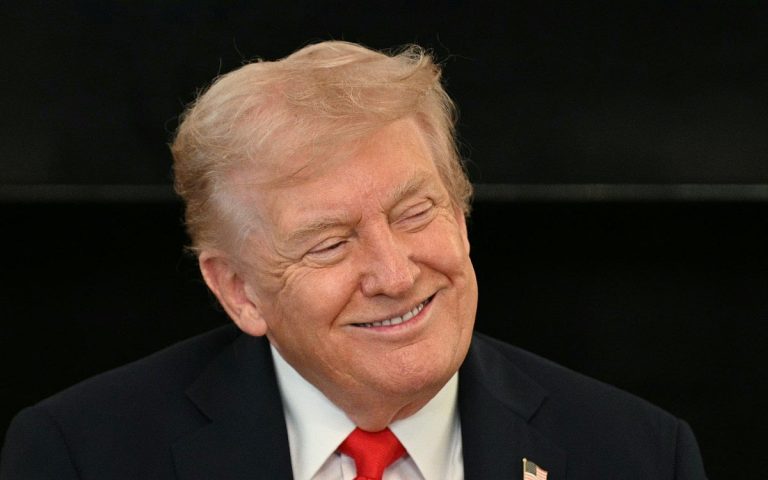Trump Considers One-State or Two-State Solution for Peace
In the wake of a fragile truce in Gaza, U.S. President Donald Trump has expressed his intention to determine the future of peace in the Middle East. While celebrating what he called a “historic dawn,” Trump emphasized the need for careful consideration of whether a one-state or two-state solution would best serve the region. His remarks come as violence continues to challenge the ceasefire, raising questions about the sustainability of peace efforts.
Trump’s Position on Peace Solutions
During a flight back to Washington, Trump addressed reporters, stating, “A lot of people like the one-state solution, some like the two-state solution. We’ll have to see.” He indicated that his decision would involve consultations with other nations, highlighting the importance of international collaboration in the peace process.
Despite Trump’s optimistic outlook, violence erupted in Gaza City and Khan Yunis on the same day. Reports from Gaza’s civil defense agency, operated by Hamas, indicated that six Palestinians lost their lives in two separate incidents involving Israeli forces.
Incidents of Violence Amid Ceasefire
In Shujaiya, Israeli drones reportedly opened fire on civilians who were inspecting their homes. Mahmud Bassal, a spokesman for the civil defense agency, detailed the incident, emphasizing the civilian nature of those targeted. The Israeli military, however, defended its actions, claiming that troops fired upon individuals who were approaching their positions and posed a threat.
Another incident in Al Fukhari, southeast of Khan Yunis, resulted in one fatality due to what Gaza officials described as a drone strike. The Israeli army asserted that the group targeted had posed an immediate threat to their troops near a former Hamas weapons site. The ongoing violence underscores the challenges of maintaining peace in the region, particularly with media restrictions complicating independent verification of casualty reports.
International Reactions and Future Steps
Francesca Albanese, the UN Special Rapporteur on the occupied Palestinian territory, condemned the recent violence, criticizing Israel’s actions as undermining the ceasefire. She remarked on social media, “Ceasefire according to Israel = ‘you cease, I fire,’” suggesting that the situation remains precarious.
The Sharm Al Sheikh declaration, which outlines a 20-point plan for Palestinian self-determination and statehood, emphasizes the need for U.S.-led discussions to establish a framework for peaceful coexistence. Trump has stated that reconstruction and reform in Gaza must precede any lasting peace agreement. “When Gaza redevelopment advances and reform takes hold, the conditions will finally be right for lasting peace,” he noted.
FAQs
What is the current status of the Gaza ceasefire?
The Gaza ceasefire is currently in effect but is being tested by ongoing violence, including recent incidents involving Israeli military actions against civilians.
What are the main points of the Sharm Al Sheikh declaration?
The Sharm Al Sheikh declaration outlines a 20-point plan aimed at establishing a credible pathway to Palestinian self-determination and statehood, along with a commitment to U.S.-led peace talks.
How does Trump plan to involve other countries in the peace process?
Trump has indicated that he will coordinate with other nations to determine the best approach for peace in the Middle East, whether that involves a one-state or two-state solution.
Conclusion
As the situation in Gaza continues to evolve, the potential for lasting peace remains uncertain. President Trump’s commitment to deciding the future of the region, alongside international collaboration, may play a crucial role in shaping the next steps. However, the recent violence serves as a stark reminder of the challenges that lie ahead in achieving a stable and peaceful resolution.
The complexities of the Israeli-Palestinian conflict have persisted for decades, with various attempts at peace negotiations often faltering due to deep-rooted political, territorial, and cultural disputes. The one-state solution proposes a single state for both Israelis and Palestinians, while the two-state solution advocates for the establishment of an independent Palestinian state alongside Israel. Each approach carries its own set of challenges and potential implications for the region’s future.
International stakeholders, including the United Nations and various countries, have historically played significant roles in mediating peace efforts. The involvement of regional powers, such as Egypt and Jordan, is also critical, as they have direct interests in the stability of the area. The evolving dynamics of the conflict, particularly in light of recent violence, highlight the urgent need for renewed dialogue and commitment from all parties involved to foster a sustainable peace process.
Also Read:
Key Challenges After Gaza Peace Agreement Signed in Cairo
Trump Praises Sheikh Mohamed’s Leadership at Peace Summit





